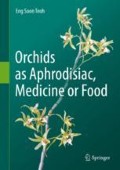Abstract
Tubers of Bletilla striata (baiji in Traditional Chinese Medicine) and three additional Bletilla species are employed in TCM as a haemostatic to treat recognizable bleeding from any source. The orchid has been used medicinally for more than 2000 years. This Chapter describes the evolution and popularization of its usage over two millennia. A baiji paste (plaster) anchored on thick paper is used to treat fissured skin. Recently, this idea has been adapted to produce Chuangyiling dressing which accelerates wound healing. Baiji in oil is used to treat burns.
Embolization, blocking the blood supply to a tumour, is one way to control its growth. Potato starch particles are usually used for embolization. In China’s unified hospital system, some doctors investigated the use of starch particles prepared with baij, and doctors at Tongji Medical University in Wuhan were able to report remarkable results using baiji-embolization to treat inoperable liver cancer. In future baiji may be employed for drug delivery and as a carrier to deliver genes to the human body.
Access this chapter
Tax calculation will be finalised at checkout
Purchases are for personal use only
References
Anonymous (1959) Preliminary observations on the treatment of haemorrhage of digestive ulcers with sepium and Bletilla hyacinthina. Zhonghua Nei Ke Za Zhi 7(1):9
Anonymous (trans) (1974) Barefoot doctors manual. NIH, Bathesda
Anonymous (2004) The new century Chinese-English dictionary of traditional Chinese medicine. People’s Military Medical Press, Beijing
Bensky D, Clavey S, Stoger E, Gambie A (2004) Herbal medicine materia medica, 3rd edn. Eastland Press, Seattle, WA
Chen XQ, Gale SW, Cribb PJ (2009) Bletilla Rchb. f. In: Chen XQ, Zj L, Zhu GH et al (eds) Flora of China—Orchidaceae. Science Press, Beijing
Dong L, Xia S, Luo Y et al (2009) Targeting delivery oligonucleotide into macrophages by a cationic polysaccharide from Bletilla striata successfully inhibited the expression of TNF-alpha. J Control Release 134(3):214–220
Feng XS, Qiu FZ, Xu Z (1995) Experimental studies of embolization of different hepatotropic blood vessels using Bletilla striata in dogs. J Tongji Med Univ 15(1):45–49
Feng G, Kramann B, Zheng C et al (1996) Comparative study of long term effect of permanent embolization of hepatic artery with Bletilla striata in patients with primary liver cancer. J Tongji Med Univ 16(2):111–116
Feng GS, Li X, Zheng CS et al (2003) Mechanism of inhibition of tumor angiogenesis by Bletilla colloid—an experimental study. Yo Xue Za Zhi 83(5):412–416
Guo JX (1996) Bletilla striata (Thunb.) Reichb.f. In: Kimura et al (ed) International collation of traditional and folk medicine, vol 1. World Scientific, Singapore, p 205
Li Shizhen (1578 date of completion) Bencao Gangmu (published posthumously, 1596. Hu Chenglong, Nanjing)
Liu XR, Han WQ, Sun DR (1992) Treatment of intestinal metaplasia and atypical hyperplasia of gastric mucosa with Xiao Wei Yan powder. Zhongguo Zhong Xi YiJie He Za Zhi 12(10):602–603
Luo Y, Diao HJ, Xia SH et al (2010) A phyiologically active polysaccharide hydrogel promotes wound healing. J Biomed Mater Res 94A(1):193–204
Nguyen Van Doung (1993) Medicinal plants of Vietnam, Cambodia and Laos. Nguyen Van Duong, Hanoi
Peng R, Zheng Q, Hao J et al (2005) Biological evaluation of ChuangYuLing dressing—a multifunctional medicine carrying biomaterial. J Huazhong Univ Sci Technolog Med Sci 25(1):72–74
Perry LM, Metzger J (1980) Medicinal plants of East and Southeast Asia: attributed properties and uses. MIT Press, Cambridge, MA
Rhee JK, Kim PG, Baek BK et al (1982) Isolation of anthelmintic substance on Clonorchis sinensis from tuber of Bletilla striata. Kisaengchunghak Chapchi 20(2):142–146
Shin HR, Lee CU, Park HJ et al (1996) Hepatitis B and C virus, Clonorchis sinensis for the risk of liver cancer: a case-control study in Pusan, Korea. Int J Epidemiol 25(5):933–940
Sterckx R (2008) The limits of illustration: Animalia and Pharmacopeia from Guo Pu to Bencao Gangmu. Asian Med 4(2):357–394
Tagaki S, Yamaki M, Inoue K (1983) Antimicrobial agents from Bletilla striata. Phytochemistry 22:1011–1015
Wang KX, Zhang RB, Cui YB et al (2004) Clinical and epidemiological data of patients with clonorchiasis. World J Gastroenterol 10(3):446–448
Yang YL, Wu KJ, Lu G (eds) (1999) Traditional Chinese materia medica. Wuhan University Press, Wuhan
Yang X, Tang C, Zhao P, Shu G et al (2012) Antimicrobial constituents of Bletilla ochracea. Planta Med 78(6):606–610
Zheng C, Feng G, Zhou R (1996) New use of Bletilla striata as embolizing agent in the intervention treatment of hepatic carcinoma. Zhonghua Zhong Gu Za Zhi 18(4):305–307
Zheng C, Feng G, Liang H (1998) Bletilla striata as a vascular embolizing agent in interventional treatment of primary hepatic carcinoma. Chin Med J 111:10060–11063
Author information
Authors and Affiliations
Rights and permissions
Copyright information
© 2019 Springer Nature Switzerland AG
About this chapter
Cite this chapter
Teoh, E.S. (2019). Metamorphosis. In: Orchids as Aphrodisiac, Medicine or Food. Springer, Cham. https://doi.org/10.1007/978-3-030-18255-7_5
Download citation
DOI: https://doi.org/10.1007/978-3-030-18255-7_5
Published:
Publisher Name: Springer, Cham
Print ISBN: 978-3-030-18254-0
Online ISBN: 978-3-030-18255-7
eBook Packages: Biomedical and Life SciencesBiomedical and Life Sciences (R0)

